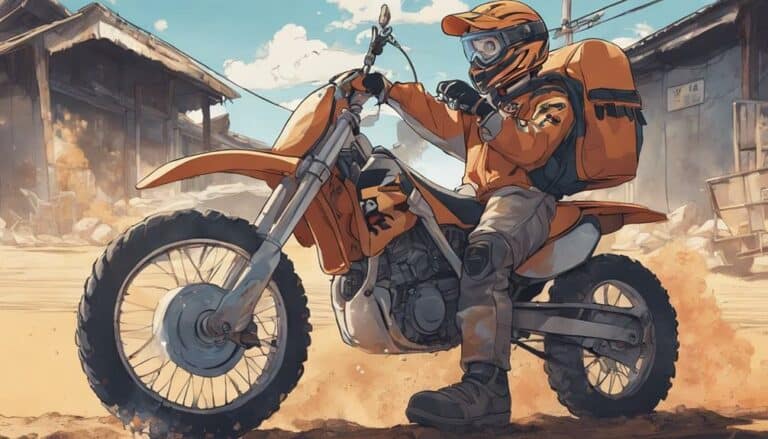If starting a fuel-injected dirt bike that's been sitting for a few months feels like reviving a dormant engine, you're not alone. But fear not, as the process doesn't have to be as intimidating as it seems.
By following a few key steps, you can guarantee your bike roars back to life with ease. From checking the fuel system to evaluating the engine health, each step plays an essential role in getting your bike back on the trail.
So, let's delve into the details and get your dirt bike running smoothly once again.
Key Takeaways
- Verify fuel system for blockages and add stabilizer.
- Check spark plug condition and clean connections.
- Confirm battery voltage and address any electrical issues.
- Prime fuel pump, power up injection system, and start with throttle.
Check Fuel System
Check the fuel system thoroughly for any signs of contamination or blockages that could hinder the engine's performance before attempting to start your fuel-injected dirt bike after storage. Begin by inspecting the fuel tank for any remnants of old gas or debris. It's important to confirm the tank is clean and free from any contaminants that could clog the fuel lines or injectors.
Next, examine the fuel lines for any obstructions that may have formed over time. Blocked fuel lines can prevent the proper flow of fuel to the engine, leading to starting issues. Additionally, check the fuel injectors for any buildup or blockages that could affect their performance.
Before starting the bike, consider adding a fuel stabilizer to the tank to prevent any problems associated with stale fuel. Turn the ignition on and listen for the fuel pump priming to verify that fuel is being delivered correctly. If the engine struggles to start or runs rough, draining the old fuel and replacing it with fresh gas may improve performance.
Proper maintenance of the fuel system is essential for best engine performance and reliability.
Inspect Electrical Components
Inspect the battery and electrical connections on your fuel-injected dirt bike for any signs of corrosion or damage before attempting to start the engine.
- Check Spark Plugs: Verify the spark plugs are clean and in good condition to facilitate proper ignition.
- Confirm Kill Switch: Examine the kill switch and other plug-in electrical connections for any potential issues that may hinder starting.
- Clean Plug-In Connections: Use electrical cleaner to clean and reseat any plug-in connections that could be causing starting problems.
It is important to address any electrical issues before starting your fuel-injected dirt bike. By installing a new battery and ensuring all electrical components are in optimal condition, you pave the way for a successful start-up.
A well-maintained electrical system is crucial for the proper functioning of the Fuel Injected (FI) system and the new injector. Remember, after letting it sit for a while, taking the time to inspect and maintain the electrical components can save you from potential headaches down the road.
Verify Battery Condition
To guarantee peak starting power for your fuel-injected dirt bike, it is crucial to verify the condition of the battery. Start by checking the battery voltage with a multimeter; it should read above 12.6 volts for peak performance. Make sure the battery terminals are clean and securely connected to prevent any potential electrical issues. Consider using a battery tender or charger if the voltage is low to restore the charge. Inspect the battery for any signs of damage or corrosion, as these can hinder its functionality. If the battery is older or displaying signs of weakness, such as struggling to hold a charge, it may be time for a replacement to ensure reliable starting power.
| Battery Condition Check | Important Actions |
|---|---|
| Battery Voltage | Check with multimeter |
| Battery Terminals | Clean and secure |
| Signs of Damage | Inspect for corrosion |
| Signs of Weakness | Consider replacement |
Assess Engine Health
When evaluating the engine health of your fuel-injected dirt bike, make sure to assess the overall performance and functionality to maintain peak operation.
Check the battery voltage and connections to guarantee sufficient electrical power for starting the bike without any hitches.
Inspect the fuel system meticulously for any signs of gumming or blockages that could impede proper fuel delivery to the engine.
Verify the condition of the spark plugs, making certain they're clean and in good shape to facilitate efficient ignition during startup.
Remember to turn the key to the 'on' position to activate the fuel pump and allow the system to pressurize before attempting to start the bike. Additionally, consider using a fuel injector cleaner or additive to help clean and lubricate the fuel system components, guaranteeing everything is primed for optimal performance.
Test Start the Bike
Before initiating the test start procedure for your fuel-injected dirt bike, make sure the fuel tank level is adequate.
Turn the ignition key to the 'On' position to power up the fuel injection system.
Press the starter button while giving the bike some throttle to assist the fuel injectors in spraying fuel into the engine.
Listen attentively for the engine to start and run smoothly, indicating important fuel injection system function.
In case the bike struggles to start, consider priming the fuel pump or checking for any fuel system issues that may be impeding the engine start.
Ensuring the important functioning of the fuel injectors and the fuel system is crucial after letting the bike sit for an extended period.
Conclusion
After following these maintenance steps, your fuel-injected dirt bike should be ready to start smoothly. Are you prepared to experience the thrill of riding once again?
With a well-maintained bike, you can confidently hit the trails and enjoy the power and performance of your machine.
Remember to regularly check and maintain your bike to guarantee performance and longevity. Get ready to ride!

